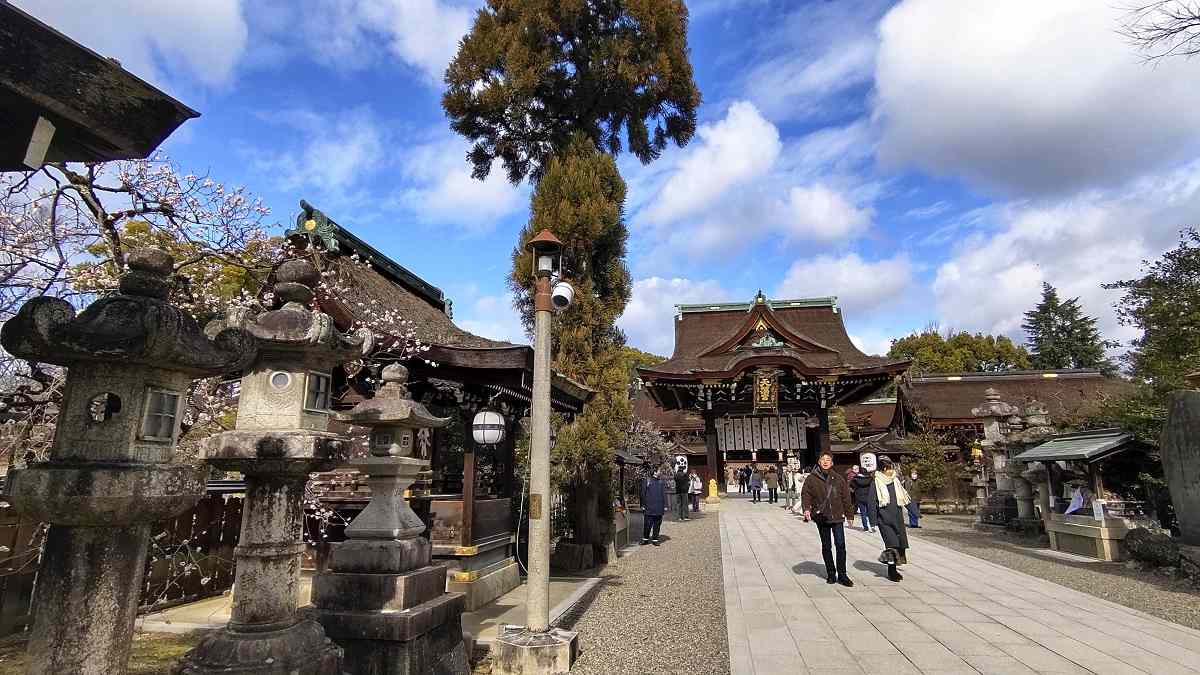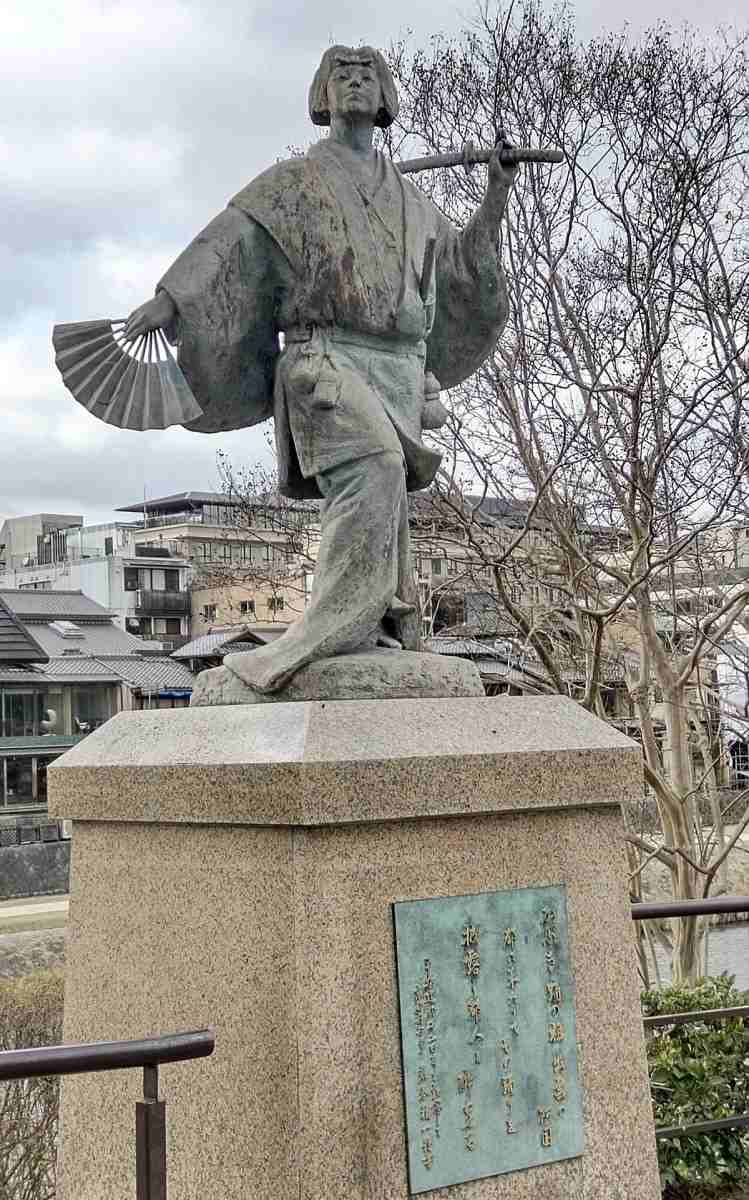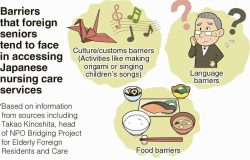Secrets of Kyoto / The Legendary Woman Behind History of Kabuki; Investigating the Real Origins of Kabuki

Minamiza Theatre, a kabuki theater run by Shochiku Co. in Higashiyawa Ward, Kyoto
10:00 JST, March 4, 2024
Did you know that kabuki, Japan’s unique theatrical style, was born in Kyoto?
At the east end of the Shijo Ohashi bridge on the Kamo River in the city stands a statue of Izumo no Okuni, the legendary figure believed to have founded kabuki around the beginning of the 17th century. Diagonally across the street from the statue and beside the Minamiza Theatre, a kabuki theater run by Shochiku Co., a stone monument commemorates the birthplace of Okuni kabuki.
In “Todaiki,” a chronicle contemporary to the period, there is an article that documents Tokugawa Ieyasu, to whom the Emperor in Kyoto gave the title of shogun, entering Fushimi Castle, his residence in present-day Fushimi Ward, Kyoto, on April 16, 1603. That article goes on to say that “There was a dance called kabuki odori around that time.”

Left: A dancing Okuni dressed as a man is shown in the center right of “Okuni Kabuki Screen,” owned by Kyoto National Museum.
Right (Close Up): “Okuni Kabuki Screen,” owned by Kyoto National Museum, depicts Okuni dancing, dressed as a man.
The article explains that the dance, performed by Okuni, a woman who came to Kyoto from Izumo in eastern Shimane Prefecture, was popular among people of all ranks in Kyoto. It says Okuni also visited the castle and performed a dance in which she dressed as a man and played with teahouse girls.
The article also explains that because Okuni resembled kabuki-mono, or samurai who were known to dress in eccentric outfits, her dance was called “kabuki odori.”
In contemporary kabuki, men play both male and female roles, but the historical document tells us that its founder was a woman who dressed as a man.
Nevertheless, kabuki performed by women — there were actually some male performers, too — was banned in 1629 by the Edo shogunate. Many of the female performers were also prostitutes, and fighting often broke out over the women. The shogunate became concerned that the situation could affect public morals.
Meanwhile, wakashu kabuki, a form of kabuki performed by boys, also became popular at that time.
After wakashu kabuki was also banned by the shogunate in 1652 for a reason similar to that for performances by women, kabuki performed only by male adults took root and continues to the present day.
But getting back to Okuni, her troupe was also invited to a palace.
According to “Keicho Nikkenroku,” the diary of an aristocrat, a person said to have come from Izumo performed kabuki odori on May 6, 1603, at the palace of Emperor Goyozei’s mother, located in the northeast corner of the Kyoto Imperial Palace.
“‘Keicho Nikkenroku’ and ‘Todaiki’ are the only two historical materials that describe the kabuki performance in 1603 in any detail,” the late Kyoko Ogasawara, a former professor emeritus at Musashi University and a renowned scholar of Okuni, once told me in an interview.
It has long been believed that the first kabuki performance took place on the banks of the Kamo River near the Shijo Ohashi bridge known as the Shijo Gawara riverside area, because seven playhouses existed there during the Genna era (1615-24) and it became the center of kabuki.
According to Ogasawara, however, that is nothing more than an assumption. There is a passage in “Uraminosuke,” a book from the early Edo period written in kana, about a trip to Kitano in present-day Kamigyo Ward, Kyoto, to see kabuki, as well as describing the events, manners and customs of that time. “Rokuon Nichiroku,” a diary of a Buddhist monk, also mentions a kabuki performance in Kitano in the New Year of 1604.
Based on these documents, Ogasawara concluded that the precincts of Kitano Tenmangu shrine in the ward was the location of the first kabuki performance.

The precincts of Kitano Tenmangu shrine in Kamigyo Ward, Kyoto, where the first kabuki performance of Izumo no Okuni is believed to have been held
There are also several folding screen paintings depicting Okuni dancing on the noh stage at the Tenmangu shrine, although it is not clear in which period the performance took place.
Ogasawara said the statue of Okuni still stands at the foot of the bridge instead of being moved to the Kitano area because “everyone is holding back for Shochiku, which has a monopoly on the kabuki theater business.”

The statue of Izumo no Okuni stands at the east end of Shijo Ohashi bridge in Higashiyama Ward, Kyoto.
"JN Specialities" POPULAR ARTICLE
-

The Japan News / Weekly Edition (12/12-12/18)
-

Noodle Dining Shunsai / Rich Oyster Ramen to Savor at Odasaga; Experienced 68-year-old Owner Creates Numerous Ramen Varieties
-

The Japan News / Weekly Edition (12/5-12/11)
-

People Keep Loved Ones’ Ashes Close in Special Jewelry, Small Urns as Unique Way to Memorialize Them
-

The Japan News / Weekly Edition (12/19-12/25)
JN ACCESS RANKING
-

Tokyo Economic Security Forum to Hold Inaugural Meeting Amid Tense Global Environment
-

Keidanren Chairman Yoshinobu Tsutsui Visits Kashiwazaki-Kariwa Nuclear Power Plant; Inspects New Emergency Safety System
-

Imports of Rare Earths from China Facing Delays, May Be Caused by Deterioration of Japan-China Relations
-

University of Tokyo Professor Discusses Japanese Economic Security in Interview Ahead of Forum
-

Japan Pulls out of Vietnam Nuclear Project, Complicating Hanoi’s Power Plans

























